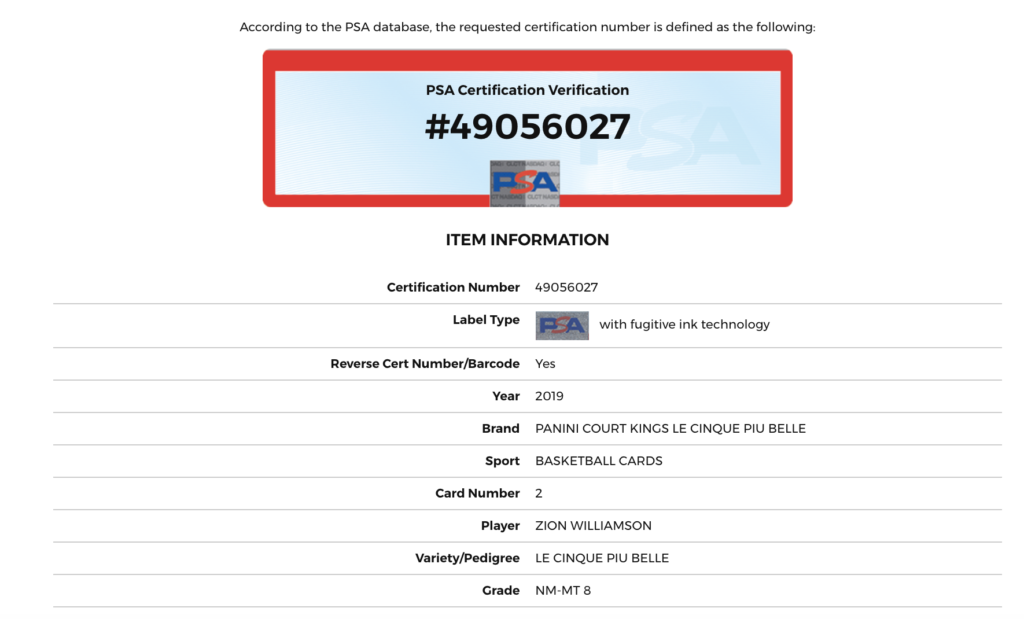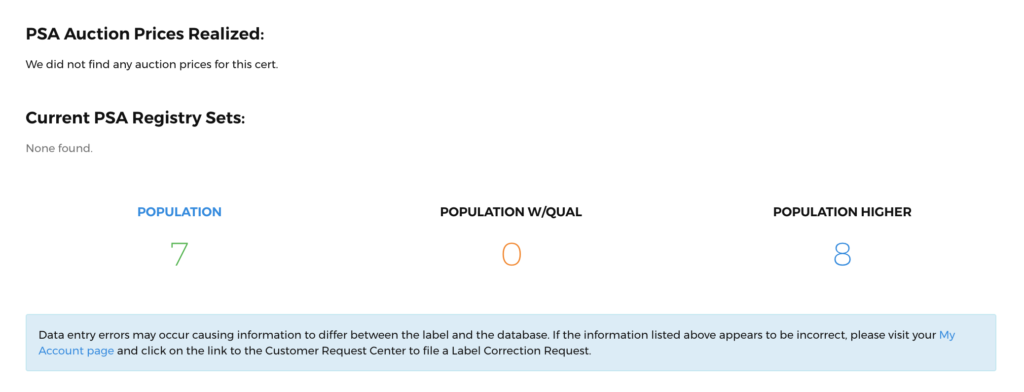How To Create Accurate Sports Card Sales Comps
So you want to sell your sports cards? Or at least understand what they're worth?
The best way to sell a sports card is to first create an accurate sales comp, then of course make your listing look good. In this post, we'll be primarily focused on the former.
Although technically I've been collecting Sports Cards since I was 8 years old, I really only collected heavily from 1989-1994, then paused big time until early 2021.
After getting back into what many call "The Hobby," I realized that "The Hobby" is actually dead, and what we're living in now is a world of Competitive Sports Card Collecting, which, quite frankly suits the forty year old version of me better than trying to put together sets like the 8 year old version of me did more than 30 years go.
Why? Because collecting competitively combines predictions related to player success, grading company values, market demand vs. supply along with vintage vs. current, set type and more.
All of the variables are super fun, which leads me to the topic of how to establish sales comps for each of the sports cards you're looking to buy, hold or sell.
Establishing sales comps are important for two main reasons:
1. If you want to sell your cards, offering them for fair market value is essential
2. It's important to know what your cards are actually worth
Collectors and investors know what cards are going for and follow popular cards closely, so it's nearly impossible to move frequently sold cards for much more than their recent sales comps on eBay, which we'll get to in a second.
But the harder part is establishing a sales comp for a less frequently sold card. While it's fun to think you can just make up your own prices for those (which technically you can), there is math to figuring out what the sales comp would project to be, and it's pretty firm. If you want to sell cards that don't have sales comps, this article will help walk you through that math.
But first, let's cover the basic way to find sales comps on eBay.
Using eBay Sold Listings to establish Comps. Open eBay.com in a browser tab and get ready to start searching EVERY. SINGLE. CARD you own. Well, calm down. All the ones you're really curious as to the value of. Type each full card name into the eBay search bar but before you click “search” add “PSA 10,” “PSA 9,” and “PSA 8” with each search. So you’re basically doing three different searches for each card, and cataloging the value of its PSA 10, PSA 9 and PSA 8.
Once the results show, go over to the side filters and click “Show More Filters” until you see “Sold Items.” Select “Sold Items.” This should now show you Completed and Sold items in Date Order of when they were sold and how much they were sold for. The numbers will be colored green. Ignore those with a Strikethrough. Those didn’t actually sell. Pick the median number for each card.
This should give you the average sales comp for your card(s). Now, sellers will want to use the highest comp, while buyers will likely want to use the lower or even lowest comp. I think median is fair.
I need to give a shout out here to my Uncle Arthur. When I was about 8 years old, I distinctly remember him telling me, “You know Paul, that card is only worth $50 if you can find someone to pay you $50 for it.”
Well Uncle Arthur, while you may balk at eBay’s initial listing results, you can’t balk at the “Sold Items” filtered results my friend! 🙂
What we’re doing here is gathering eBay comps. This is the exact same as your realtor pulling comps of recently sold homes in your neighborhood before you list your house for sale.
But, the real question is, what are we supposed to do when we can't find any comps for the specific card we're trying to list for sale? Or purchase?
For example, a 2019 Panini Court Kings Zion Williamson Le Cinque Piu Belle ungraded comps for around $1k safely as of this writing.
A BGS 9 of the same card comps at 1,225.00.
So why wouldn't a PSA 8 sell for $850? Well, first of all, there are no comps at all for a PSA 8 of this card, so buyers aren't really sure how to price it.

So what we need to do is establish a comp, and explain our rationale to the buyer within our sales listing.
In a recent study (Data Over Opinions, baby), NoOffseason.com found that the average PSA 8 comp is MAXIMUM 12% of its PSA 10 equivalent.
This means that if a Kobe Bryant PSA 10 rookie goes for $6k, its PSA 8 is going to go for a maximum of $500.
Disappointed? Well, there's more. Not only will a PSA 8 currently only go for a maximum of 12% of the PSA 10 value, but an ungraded card many times will go for much more than a PSA 8.
Why, you ask?
Well, even though it's nearly impossible to get a card graded by PSA, and the grading fee alone is usually a minimum of $25 - $50, the sheer HOPE of a PSA 10 is worth more to most buyers than an already graded PSA 8.
Crazy, right?
If you don't yet follow, think of it this way. You buy a lottery ticket that could win $1,000. You're given the opportunity to either keep that lottery ticket, or get a free $100 bill handed to you. What do you do?
The PSA 8 is the free $100. It's $100, but NO CHANCE of $1,000.
The ungraded card is the chance. The chance at the PSA 10, which would be worth 9x more.
Keep in mind this is not always the case, but check to see what your card is going for ungraded vs. PSA 8 before submitting it for grading.
So, unfortunately, the comp I'd create for the PSA 8 version of the 2019 Panini Court Kings Zion Williamson Le Cinque Piu Belle would be:
BGS 9 is typically 10% of a PSA 10
So with no PSA 10 comp to go on, we say it would be $1,225 (the latest comp of a BGS 9) * 1.9 = $2,327.50
* .12 = $279.30
This is our comp for a PSA 8 2019 Panini Court Kings Zion Williamson Le Cinque Piu Belle = $279.30
A quick cheat sheet to the data is SportsCardInvestor.com. For free, the website and the mobile app (which is prime for extra fun research while pooping) shows you the top ~7,000 Sports Cards and their current market movement on eBay, including tabs for current listings and recent sales. Again, pay attention only to recent sales.
The reason you’ll need eBay in addition to SportsCardInvestor.com is because only about 20% of your cards will show on the free version of SportsCardInvestor.com, although they do have a premium product called Market Movers that claims to have all cards in it, but I’ve never used it - so I can’t verify that.
And Market Movers costs $25/month minimum, so this math and approach saves you a bit of money - leaving you with more to buy cards with. 🙂
So accurately pricing your card is important, as well as making your sales listing look good. Taking clear, focused pictures of both the front and back with nothing in the background is just the start. Regardless of where you're selling, you'll want a clear title to the card - the full name - best for search and reducing confusion. In my earlier example's case, the name of the listing should be: 2019 Panini Court Kings Zion Williamson Le Cinque Piu Belle PSA 8.
The description of the card should include your rationale for pricing, and the PSA Cert info and POP Count from PSA, in this case, since it's the company that graded the card. The lower the POP count, the better. In this card's case, here's what that looks like:


In this case, the seller could market the fact that there are only 7 PSA 8s and less than 10 total PSA 10s and 9s, making the graded version of this card SUPER RARE!
Paul Hickey is a Digital Creator, spending about about 60% of his work time building WordPress websites for small businesses, 20% of his work time running an eCommerce Sports Cards and Digital Collectibles business at NoOffseason.com and another 20% of his work time authoring books and creating digital art in the form of NFTs (Non-Fungible Tokens).
In each of his entrepreneurial endeavors, he believes it's important to create a community. He strives to do this by creating helpful content for his audience (community members) to learn about the topics he's interested in.
This is why he creates content on the following topics:
Spread the word. Share please.
